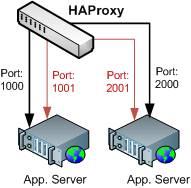BEGIN
DECLARE cursor_ID INT;
DECLARE tmp VARCHAR (20) DEFAULT "";
DECLARE cursor_VAL VARCHAR (20) DEFAULT "";
DECLARE done INT DEFAULT 0;
DECLARE cursor_i CURSOR FOR SELECT id, sub_key FROM tmp_mtv_sub_vod6 ORDER BY sub_key ASC, status DESC, price ASC;
DECLARE CONTINUE HANDLER FOR NOT FOUND SET done = TRUE;
OPEN cursor_i;
read_loop: LOOP
FETCH cursor_i INTO cursor_ID, cursor_VAL;
IF done THEN
LEAVE read_loop;
END IF;
if tmp = cursor_VAL THEN
delete from mtv_sub_vod where id = cursor_ID;
END IF;
SET tmp = cursor_VAL;
END LOOP;
CLOSE cursor_i;
END
Thứ Tư, 26 tháng 8, 2015
Thứ Tư, 12 tháng 8, 2015
Zero-Downtime Restarts with HAProxy

Putting up a maintenance page while you are doing an update and restarting your application servers is good practice, but it definitely hurts the user experience. This, in turn, translates to less frequent releases and frustration for both the developer and the users (release often, release early!). To address this, the Rails community has come up with a couple of approaches to mitigate the problem: Seesaw, one-at-a-time restarts, and Swiftiply, none of which, unfortunately, caught on with the crowd. Well, it turns out, HAProxy has a beautiful solution for this problem!
Existing Solutions
The challenge with doing a rolling restart is in the coordination between your application servers, and an upstream reverse-balancer (HAProxy, Nginx, Apache, etc.). In theory, if you have a cluster of servers, you could cycle them one after another, as Carl has suggested, but that means that the upstream balancer is unaware of the maintenance window, and hence it may dispatch a request to a bad server - resulting in either a dropped request, or a hiccup in response time.Swiftiply offers a much cleaner solution to this problem: each application server connects to the proxy itself, and thus the cluster can be dynamically modified at runtime. Great idea, but there is the unfortunate Ruby dependency - what if we're running a non Ruby service?
Seamless Restarts With HAProxy
 HAProxy architecture document
shows that we can specify a backup for every application server in our
cluster. Thus, if you're running a mission critical application, you
could specify a hot standby which is ready to take over the traffic.
Nice feature, but we're going to use it for a slightly different
purpose.
HAProxy architecture document
shows that we can specify a backup for every application server in our
cluster. Thus, if you're running a mission critical application, you
could specify a hot standby which is ready to take over the traffic.
Nice feature, but we're going to use it for a slightly different
purpose.Instead of specifying a physically different app server, we're going to define our backup instance to be the exact same application server in each case, but with one minor difference: the status port, for the main app server will be different from the one we use on the backup.
backend srvs
# webA and webB are monitored on different ports from backup servers
# but bkpA, webA and bkpB and webB are actually the same server!
server webA 127.0.0.1:1000 check port 2000 inter 2000
server webB 127.0.0.1:1001 check port 2001 inter 2000
server bkpA 127.0.0.1:1000 cookie A check port 1000 inter 2000 backup
server bkpB 127.0.0.1:1001 cookie B check port 1001 inter 2000 backupUsing IPTables to Notify HAProxy
Let's take webA as an example: the backup server listens on port 1000, and status port for backup is set to 1000 (HAProxy pings the server on that port every two seconds to see if its up), but the 'main' instance will have a different status port, which we will forward with IPTables:# forward port 2000 to 1000
$ iptables -t nat -A OUTPUT -p tcp --dport 2000 -j REDIRECT --to-port 1000
$ iptables -t nat -A PREROUTING -p tcp --dport 2000 -j REDIRECT --to-port 1000
# remove port forwarding from 2000 to 1000
$ iptables -t nat -D OUTPUT -p tcp --dport 2000 -j REDIRECT --to-port 1000
$ iptables -t nat -D PREROUTING -p tcp --dport 2000 -j REDIRECT --to-port 1000
rolling-restart.zip - Test setup, and configuration files
Migrating Server In/Out of Maintenance
Now, if we want to put the server into maintenance mode, we remove the IPTables rule for the forwarded port, and wait a few seconds so that our upstream HAProxy instance recognizes that the server is no longer available for new connections - this is key, it means that no client is dropped in the process. Now, once the server is out of rotation in HAProxy, we can do a graceful restart, add the IPTables rule back in, and we're live! Hence, the full restart sequence is:- Delete IPTables rule for the status port
- Wait for HAProxy to take server out of rotation for new clients
- Perform graceful restart of the application server
- Add IPTables rule for the status port
Source: https://www.igvita.com/2008/12/02/zero-downtime-restarts-with-haproxy/
Thứ Bảy, 8 tháng 8, 2015
PROCESS STATE CODES
PROCESS STATE CODES Here are the different values that the s, stat and state output specifiers (header "STAT" or "S") will display to describe the state of a process: D uninterruptible sleep (usually IO) R running or runnable (on run queue) S interruptible sleep (waiting for an event to complete) T stopped, either by a job control signal or because it is being traced. W paging (not valid since the 2.6.xx kernel) X dead (should never be seen) Z defunct ("zombie") process, terminated but not reaped by its parent.
For BSD formats and when the stat keyword is used, additional characters may be displayed: < high-priority (not nice to other users) N low-priority (nice to other users) L has pages locked into memory (for real-time and custom IO) s is a session leader l is multi-threaded (using CLONE_THREAD, like NPTL pthreads do) + is in the foreground process group.Source: http://askubuntu.com/questions/360252/what-do-the-stat-column-values-in-ps-mean
Đăng ký:
Nhận xét (Atom)